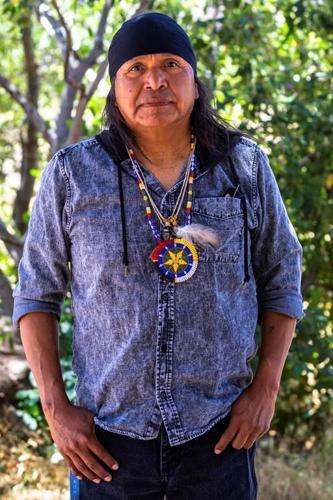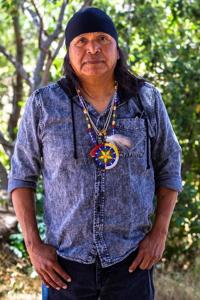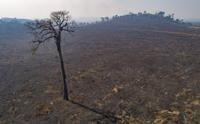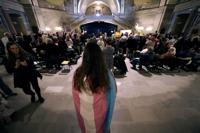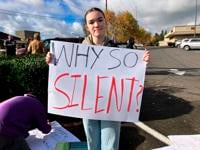OAK FLAT, Ariz. (AP) — Azee Romero climbed barefoot on the wrinkled trunk of the massive Emory oak tree at the center of the Oak Flat Campground.
The 5-year-old in his dinosaur t-shirt, with hair tied under a backwards baseball cap, scaled higher and higher until he found the perfect seat. There, cradled by the sturdy trunk, the boy smiled and rested comfortably as if he’d just climbed onto the lap of a grandparent.
In fact, that centuries-old oak tree and the ground below it – the sacred, ancestral flats that stretch for miles east of Phoenix -- are like kin to Azee’s family.
“My little guy, his umbilical cord is buried here,” said Azee’s mother, Lian Bighorse. She said the connection to Oak Flat is physical as well as spiritual.
The family is Chiricahua Apache, and Oak Flat, or Chi’chil Bildagoteel, is a consecrated place used for prayer and ritual by them and many other Native American peoples in the region. Elders say the land was blessed by Usen, their Creator, and inhabited by Ga’an, the mountain spirits or angels who provide spiritual succor and guidance to seekers.
But they fear for its future, seeing plans to carve a huge copper mine into the heart of Oak Flat as if it were a threat to their own flesh and blood – an obliteration of a piece of their spiritual heritage.
___
The 6.7-square-mile Oak Flat is a verdant oasis in an arid landscape dotted with towering saguaro cacti, majestic rock spires and sweeping canyons.
Here, sage and other plants used for medicinal and ritual purposes sprout along streams and wetlands that provide sanctuary for birds and other animals. It’s where Native people gather acorns that drop from the oak trees before crushing them into an edible powder, and pick red sumac berries for a refreshing, scarlet drink that Bighorse described as “Native Kool-Aid.”
It is also here that Resolution Copper Mining, a joint subsidiary of British and Australian mining giants, Rio Tinto and BHP, wants to remove layers of rock in order to extract copper from deep underground. The in-demand metal is necessary for electric vehicle and cell phone manufacturing. In the works for nearly a decade, the project has stalled amid a legal and political fight between U.S. agencies and the nonprofit group, Apache Stronghold, which is trying to protect Oak Flat on religious grounds.
Resolution Copper President Vicky Peacey said the mine will be a “massive investment in rural Arizona” creating about 3,700 jobs over the course of the project.
But removal of ore from underground would eventually cause the ground surface to collapse into a 1.8-mile (2.9-kilometer) crater. Native people say the mine will desecrate Oak Flat, a site for coming-of-age rituals for Apache women, healing sweat lodge ceremonies and other big and small moments in the lives of Native people.
Bighorse’s 12-year-old daughter, Soleil Davignon, is preparing for her upcoming Sunrise Dance. The four-day, coming-of-age ritual occurs within a year of a woman’s first menstrual period and Soleil’s ceremony is set for October.
She worries the mining could block her access to which she has a strong spiritual connection.
“This is a really sacred place,” Soleil said softly. “I love being here.”
___
Resolution began the permitting process nearly a decade ago. Apache Stronghold is challenging a planned land swap that would allow the project to move forward. The full U.S. 9th District Court of Appeals is considering the group's request to permanently halt the project, and the only thing stopping that now is the lack of a new environmental impact statement.
Apache Stronghold contends that the mine would endanger Oak Flat and prevent Native Americans from their spiritual practice, said Wendsler Nosie Sr., a longtime activist who leads the group. He lives on Oak Flat as an act of rebellion.
The former San Carlos Apache tribal chairman argues the land swap effectively declared that “the water, the air, the environment here in Oak Flat, they are all dead. … What we’ve done is given life back to it. It’s getting CPR right now through the religion.”
His tribe’s current top leadership supports Nosie’s efforts, but some members would rather have the mine and the possible job opportunities that could come with it.
They include Karen Kitcheyan-Jones, 64, the widow of a miner who never knew Oak Flat as a religious place. She had her coming of age celebration on the San Carlos Apache reservation, about 67 miles east of Oak Flat, where she still lives.
Faith traditions differ on how they define sacredness, said Dan Dalton, a Detroit-based attorney who represents religious institutions in land use and zoning cases.
In the Oak Flat case, he said the law appears to favor the Native American community since “courts have deferred to the local religious entity to determine when land becomes sacred.” The only exception, he said, would be fraud, when someone is attempting to use religion to serve an ulterior motive.
Oak Flat has spiritual significance to many Native peoples and there are spots “where even a casual observer can experience a sense of the divine,” said John R. Welch, professor of archaeology at Simon Fraser University in British Columbia who has worked extensively with Apache tribes. Evidence of its sacredness can be found in petroglyphs or rock paintings and Apache burial grounds.
__
On a recent morning, Nosie sat on a lawn chair watching young Stronghold men stoke a fire to heat the rocks that would be used later in a sweat lodge ceremony at Oak Flat. For Apache men, sitting through the ceremony’s four rounds of sweating is like returning to the mother’s womb and a reminder of women’s significance, he said.
Kooper Curley, who is Diné and from Chichiltah, New Mexico, planned to partake in the ritual, and called Oak Flat a “place of healing.” After falling into a life of drugs, gangs and violence, Kurley said re-connecting with his spiritual roots saved him.
These sacred sites have existed since the beginning of time to facilitate healing and renewal, which diminished as Native people were sent to reservations, Nosie said. He recalled that his mother would bring him and his siblings to Oak Flat when they were little. Both he and his mother grew up in an era where they were afraid to leave the reservation and set foot on Oak Flat, even though it was public land and they had a right to be there, Nosie said.
“She’d park here and ask us to take a little air out of the tires so she could pretend like she had a flat tire, just in case someone stopped her,” he said. “We’d run out, say our prayers and grab what we can and come back. Then, we’d pump up the tires and leave.”
Nosie credits his late mother for teaching him about his spiritual roots. He thinks about her as he walks around Oak Flat, picking up leaves and watching Native families have picnics under that ancient oak tree. He chokes up.
“Now, kids are running up and down the place, and they’re not scared,” he said. “We’ve come back to our spiritual home.”
___
This story has been updated to correct the last name of Resolution Copper President Vicky Peacey.
___
AP writer Anita Snow reported from Superior, Arizona.
___
Associated Press religion coverage receives support through the AP’s with The Conversation US, with funding from Lilly Endowment Inc. The AP is solely responsible for this content.



